Instruction
Understanding How The Body Affects The Golf Swing: Shoulder Bend
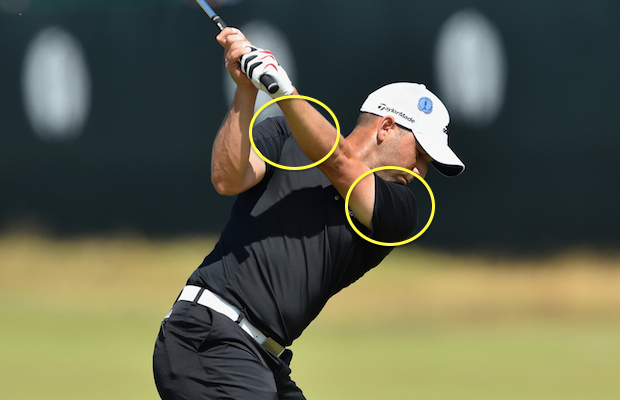
Generally speaking, in all sports, if the head is moving the body is moving with it.
In football, if you grab someone’s face mask and pull their head, the rest of the body tends to follow. So it would be of the utmost importance in a sport where the ball is not moving to eliminate any excess head movement in the backswing to prevent the body from moving excessively.
To better understand why this happens, we need to have a better understanding of what is causing it. For that, I introduce you to what is called the “shoulder bends.”
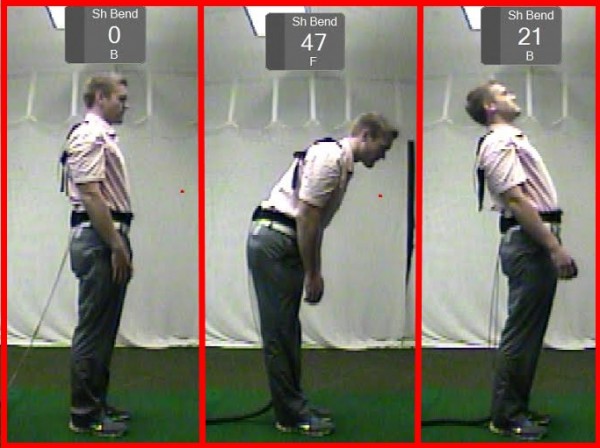
Above: Shoulder bend will always read in degrees.
In the photo above, the golfer on the left is currently standing straight up and down with NO shoulder bend. That’s why number on the image reads 0 degrees. The golfer in the middle is bent over and has 47 degrees of FORWARD shoulder bend. The more he leans forward, the more degrees of shoulder bend he will have. Finally, the golfer on the right is standing tall and leaning back and his shoulder bend reads 21 degree BACKWARD. The more he leans back, the more backward shoulder bend he will have.
Now that you understand basic shoulder bends, let’s talk about how they relate to golfers who moves their head off the golf ball and golfers who do not move off the ball.
In the golf swing, all golfers will start in a position of FORWARD Shoulder Bend as seen below.
As the golfer starts their backswing, they are slowly losing their FORWARD shoulder bend and will eventually make it to the top of the backswing and a point which ideally will have ZERO Shoulder Bend forward.
Golfers who move their head off the golf ball will start in forward shoulder bend, make their backswing, and by the time their club is up to the top of the backswing they will maintain some or the majority of their forward shoulder bend, looking like the image below. The more forward shoulder bend they have the more they will move off the golf ball.
Maintaining too much forward shoulder bend at the top of the backswing not only moves the head off the golf ball, but it creates a variety of other miscues such as fat shots, a lack of distance and directional problems.
How To Fix The Problem
Without a golf club in your hand, stand next to a door frame with your left foot nearly touching the left door jamb.
With your arms crossing your shoulders, turn and begin to simulate a backswing. This backswing shouldn’t allow your shoulder blades to move farther away from the left door jamb. In fact, feel like they are moving closer to it!
If you notice that your shoulders at the top of the backswing are farther away from the left door jamb, you have maintained too much forward bend, which is a problem. From this position, take your shoulders and begin to move or push them closer to the left door jamb. This will take your head and move it back over the golf ball and create the feeling we call “extension.” Repeat until this feel more natural.
If you can do this drill properly, you will eliminate your excessive head movement during the backswing and most likely hit the ball more solid!
- LIKE41
- LEGIT4
- WOW4
- LOL0
- IDHT0
- FLOP2
- OB1
- SHANK7
Instruction
The Wedge Guy: The easiest-to-learn golf basic

My golf learning began with this simple fact – if you don’t have a fundamentally sound hold on the golf club, it is practically impossible for your body to execute a fundamentally sound golf swing. I’m still a big believer that the golf swing is much easier to execute if you begin with the proper hold on the club.
As you might imagine, I come into contact with hundreds of golfers of all skill levels. And it is very rare to see a good player with a bad hold on the golf club. There are some exceptions, for sure, but they are very few and very far between, and they typically have beat so many balls with their poor grip that they’ve found a way to work around it.
The reality of biophysics is that the body moves only in certain ways – and the particulars of the way you hold the golf club can totally prevent a sound swing motion that allows the club to release properly through the impact zone. The wonderful thing is that anyone can learn how to put a fundamentally sound hold on the golf club, and you can practice it anywhere your hands are not otherwise engaged, like watching TV or just sitting and relaxing.
Whether you prefer an overlap, interlock or full-finger (not baseball!) grip on the club, the same fundamentals apply. Here are the major grip faults I see most often, in the order of the frequency:
Mis-aligned hands
By this I mean that the palms of the two hands are not parallel to each other. Too many golfers have a weak left hand and strong right, or vice versa. The easiest way to learn how to hold the club with your palms aligned properly is to grip a plain wooden ruler or yardstick. It forces the hands to align properly and shows you how that feels. If you grip and re-grip a yardstick several times, then grip a club, you’ll see that the learning curve is almost immediate.
The position of the grip in the upper/left hand
I also observe many golfers who have the butt of the grip too far into the heel pad of the upper hand (the left hand for right-handed players). It’s amazing how much easier it is to release the club through the ball if even 1/4-1/2″ of the butt is beyond the left heel pad. Try this yourself to see what I mean. Swing the club freely with just your left hand and notice the difference in its release from when you hold it at the end of the grip, versus gripping down even a half inch.
To help you really understand how this works, go to the range and hit shots with your five-iron gripped down a full inch to make the club the same length as your seven-iron. You will probably see an amazing shot shape difference, and likely not see as much distance loss as you would expect.
Too much lower (right) hand on the club
It seems like almost all golfers of 8-10 handicap or higher have the club too far into the palm of the lower hand, because that feels “good” if you are trying to control the path of the clubhead to the ball. But the golf swing is not an effort to hit at the ball – it is a swing of the club. The proper hold on the club has the grip underneath the pad at the base of the fingers. This will likely feel “weak” to you — like you cannot control the club like that. EXACTLY. You should not be trying to control the club with your lower/master hand.
Gripping too tightly
Nearly all golfers hold the club too tightly, which tenses up the forearms and prevents a proper release of the club through impact. In order for the club to move back and through properly, you must feel that the club is controlled by the last three fingers of the upper hand, and the middle two fingers of the lower hand. If you engage your thumbs and forefingers in “holding” the club, the result will almost always be a grip that is too tight. Try this for yourself. Hold the club in your upper hand only, and squeeze firmly with just the last three fingers, with the forefinger and thumb off the club entirely. You have good control, but your forearms are not tense. Then begin to squeeze down with your thumb and forefinger and observe the tensing of the entire forearm. This is the way we are made, so the key to preventing tenseness in the arms is to hold the club very lightly with the “pinchers” — the thumbs and forefingers.
So, those are what I believe are the four fundamentals of a good grip. Anyone can learn them in their home or office very quickly. There is no easier way to improve your ball striking consistency and add distance than giving more attention to the way you hold the golf club.
More from the Wedge Guy
- The Wedge Guy: Golf mastery begins with your wedge game
- The Wedge Guy: Why golf is 20 times harder than brain surgery
- The Wedge Guy: Musings on the golf ball rollback
- LIKE83
- LEGIT13
- WOW4
- LOL1
- IDHT0
- FLOP4
- OB1
- SHANK8
Instruction
Clement: Stop ripping off your swing with this drill!

Not the dreaded headcover under the armpit drill! As if your body is defective and can’t function by itself! Have you seen how incredible the human machine is with all the incredible feats of agility all kinds of athletes are accomplishing? You think your body is so defective (the good Lord is laughing his head off at you) that it needs a headcover tucked under the armpit so you can swing like T-Rex?
- LIKE0
- LEGIT1
- WOW2
- LOL0
- IDHT0
- FLOP0
- OB0
- SHANK2
Instruction
How a towel can fix your golf swing

This is a classic drill that has been used for decades. However, the world of marketed training aids has grown so much during that time that this simple practice has been virtually forgotten. Because why teach people how to play golf using everyday items when you can create and sell a product that reinforces the same thing? Nevertheless, I am here to give you helpful advice without running to the nearest Edwin Watts or adding something to your Amazon cart.
For the “scoring clubs,” having a solid connection between the arms and body during the swing, especially through impact, is paramount to creating long-lasting consistency. And keeping that connection throughout the swing helps rotate the shoulders more to generate more power to help you hit it farther. So, how does this drill work, and what will your game benefit from it? Well, let’s get into it.
Setup
You can use this for basic chip shots up to complete swings. I use this with every club in my bag, up to a 9 or 8-iron. It’s natural to create incrementally more separation between the arms and body as you progress up the set. So doing this with a high iron or a wood is not recommended.
While you set up to hit a ball, simply tuck the towel underneath both armpits. The length of the towel will determine how tight it will be across your chest but don’t make it so loose that it gets in the way of your vision. After both sides are tucked, make some focused swings, keeping both arms firmly connected to the body during the backswing and follow through. (Note: It’s normal to lose connection on your lead arm during your finishing pose.) When you’re ready, put a ball in the way of those swings and get to work.

Get a Better Shoulder Turn
Many of us struggle to have proper shoulder rotation in our golf swing, especially during long layoffs. Making a swing that is all arms and no shoulders is a surefire way to have less control with wedges and less distance with full swings. Notice how I can get in a similar-looking position in both 60° wedge photos. However, one is weak and uncontrollable, while the other is strong and connected. One allows me to use my larger muscles to create my swing, and one doesn’t. The follow-through is another critical point where having a good connection, as well as solid shoulder rotation, is a must. This drill is great for those who tend to have a “chicken wing” form in their lead arm, which happens when it becomes separated from the body through impact.
In full swings, getting your shoulders to rotate in your golf swing is a great way to reinforce proper weight distribution. If your swing is all arms, it’s much harder to get your weight to naturally shift to the inside part of your trail foot in the backswing. Sure, you could make the mistake of “sliding” to get weight on your back foot, but that doesn’t fix the issue. You must turn into your trial leg to generate power. Additionally, look at the difference in separation between my hands and my head in the 8-iron examples. The green picture has more separation and has my hands lower. This will help me lessen my angle of attack and make it easier to hit the inside part of the golf ball, rather than the over-the-top move that the other picture produces.


Stay Better Connected in the Backswing
When you don’t keep everything in your upper body working as one, getting to a good spot at the top of your swing is very hard to do. It would take impeccable timing along with great hand-eye coordination to hit quality shots with any sort of regularity if the arms are working separately from the body.
Notice in the red pictures of both my 60-degree wedge and 8-iron how high my hands are and the fact you can clearly see my shoulder through the gap in my arms. That has happened because the right arm, just above my elbow, has become totally disconnected from my body. That separation causes me to lift my hands as well as lose some of the extension in my left arm. This has been corrected in the green pictures by using this drill to reinforce that connection. It will also make you focus on keeping the lead arm close to your body as well. Because the moment either one loses that relationship, the towel falls.


Conclusion
I have been diligent this year in finding a few drills that target some of the issues that plague my golf game; either by simply forgetting fundamental things or by coming to terms with the faults that have bitten me my whole career. I have found that having a few drills to fall back on to reinforce certain feelings helps me find my game a little easier, and the “towel drill” is most definitely one of them.
- LIKE12
- LEGIT1
- WOW2
- LOL0
- IDHT0
- FLOP2
- OB0
- SHANK8
-

 19th Hole2 weeks ago
19th Hole2 weeks agoJohn Daly stuns fans into silence with brutal opening tee shot on PGA Tour Champions
-

 19th Hole4 days ago
19th Hole4 days agoThings got heated at the Houston Open between Tony Finau and Alejandro Tosti. Here’s why
-

 19th Hole23 hours ago
19th Hole23 hours agoReport: Tiger Woods has ‘eliminated sex’ in preparation for the 2024 Masters
-

 19th Hole2 weeks ago
19th Hole2 weeks ago2-time major champ announces shock retirement from the sport at age of 33
-

 19th Hole2 weeks ago
19th Hole2 weeks agoCharlie Woods finds it tough going on American Junior Golf Association debut
-

 19th Hole2 weeks ago
19th Hole2 weeks agoEdoardo Molinari reveals the latest PGA Tour golfer to turn down ‘good offer’ from LIV Golf
-

 19th Hole3 weeks ago
19th Hole3 weeks agoScottie Scheffler had an interesting response when asked how he ‘quiets the noise’ following Players victory
-

 19th Hole2 weeks ago
19th Hole2 weeks agoJon Rahm dealt fresh blow to hopes of qualifying for 2025 Ryder Cup

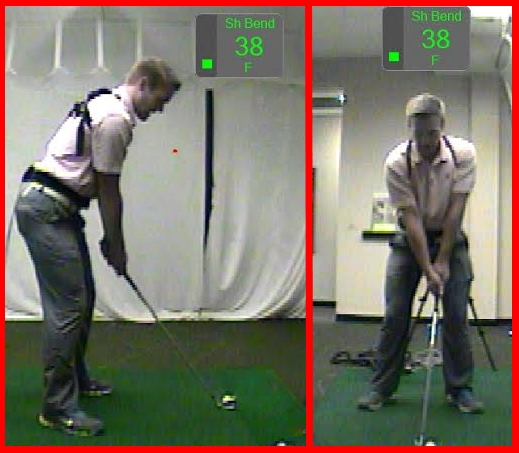
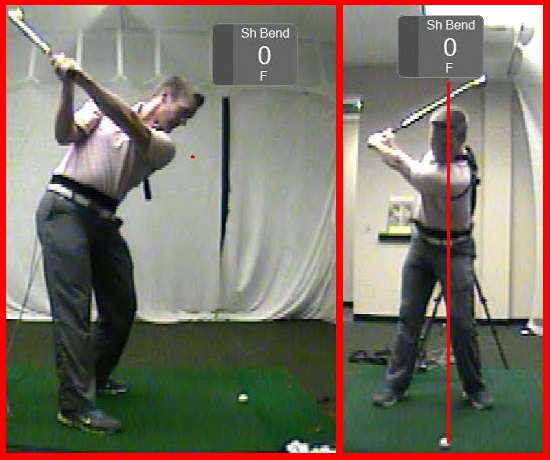
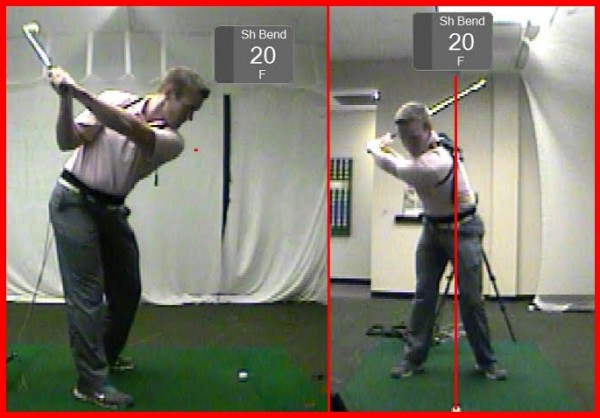


















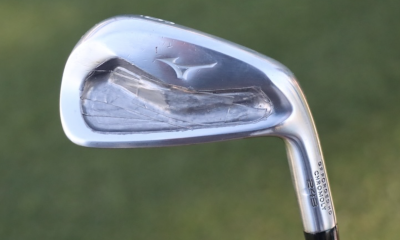

Pingback: The Importance CRM Selection
Pingback: The Importance of Bend Selection in the Golf Club - IDN PEDIA
John
Jun 5, 2016 at 6:23 pm
Why are you referring to this as ‘shoulder bend?’ The shoulders don’t bend. This is spine tilt, often referred to as primary tilt (forward tilt / back tilt).
Jason
Nov 12, 2014 at 11:56 am
Couple of questions: 1:) why when measuring shoulder bend, do we measure it from the down the line angle at address, and then from the front view at the top of the backswing? Isn’t this really measuring two different things?
2:) at address, a player should have a slight amount of spins tilt away from the target. So, at the top of the swing, if that tilt was maintained, how could we ever attain a 0 degree measurement if we didn’t reverse that initial tilt? Am I thinking of this correctly?
Scott Yurgalevicz
Nov 12, 2014 at 3:36 pm
Hi Jason, Thanks for the comments and questions. Let me see if i can answer these for you.
#1 – So technically we don’t measure shoulder bend from either angle. It is actually in 3-dimensions. In the picture about explaining shoulder bend there is a motion sensor on my back. So technically at address you can estimate shoulder bend from the down the line view, but it wont be perfect.
#2 It is true that you will start with some kind of spine tilt at address. Not a large amount though. During the backswing the golfer begins to turn and tilt, as the golfer continues back, to maintain their inclination to the ground and eliminate excessive upper body translation they will also extend their spine. That is essentially the goal of the above drill. If a golfer doesn’t extend they will then begin to translate significantly off the ball.
Essentially a golfer will be in a position of flexion (forward shoulder bend) at address, during the backswing they will be going from flexion to extension(where shoulder bend goes to somewhere around zero degrees).
Does that help?
For a visual here’s a picture i quickly googled to show Johnny Miller doing the same thing….starts with a spine tilted to his right (away from the target a few degrees).
http://asafgolf.free.fr/images/golf/swings/miller_face.jpg
Feel free to email me at [email protected] and I can try to explain it a bit more in depth for you
Pingback: Bending To Break Your Game - The Golf Shop Online Blog
antonio
Nov 11, 2014 at 4:17 am
Thanks a lot Scott for the very interesting article. I saw myself in the forward bend position and have been working lately to limit that which has improved a lot my ball striking. Also I have been using your drill basically as part of my warm up routine. Please confirm where your weight should be (left or right foot) when you make the full turn in the drill. Thanks again
Scott Yurgalevicz
Nov 12, 2014 at 3:40 pm
Antonio,
Great to hear this drill helps! I would recommend you feeling more weight on the front foot esp if you are working on eliminating forward shoulder bend at the top.
Let me know if you need anymore help. [email protected]
Steve Lippincott
Nov 10, 2014 at 11:30 am
The information Scott presents in this article is part of the GolfTEC system of coaching. It represents the change in the spine from forward to lateral flexion that every golfer does to varying degrees as verified by testing more then a million tour professionals and amateurs a like on the 3d motion capture system Golftec coaches like Scott, and myself use everyday.
After teaching more then 17,000 lessons on that system the most common pattern I see in the highest handicap golfers is too bend too far forward at the top of the swing. This greatly limits their ability to rotate and limits the amount the left arm can orbit the torso. It can also produce a greater risk of injury, though any discussion of why a golfer gets injured is subjective conjecture at best.
Lastly, Scott’s measurement of how the spine changes from forward to lateral flexion is consistent amongst the best players in the world. It’s not a Stack and Tilt invention it’s a common pattern amongst those who strike a golf ball the best.
Matt Christian
Nov 9, 2014 at 3:01 pm
http://youtu.be/_i6ucMMuzU0
Stewart Graham
Nov 9, 2014 at 8:30 am
No doubt Scott is full of enthousiam his pupils seem to be good junior / high school players well done Scott .Have you ever worked with real ordinary club golfers 50/60 / 70years old? Stiff business men, overweight ladies seniors with arthritis if they tried to keep the head still ,turn around the same axe ,they would probably end up in hospital .too many people are been taught like tour pros ,find golf more difficult than it should be and the give up the game .Just look at the Senior Tours they swing the clubhead with minimum stress on ther body ,swings that last à lifetime .Most of the players that are on the world tours at the moment wont even make it to the senior tours.By the way can anybody name me a sport where the head stays fixed? Stewart Graham PGA GB 42years Positive Impact Golf.
Scott Yurgalevicz
Nov 9, 2014 at 9:23 am
Thanks For the comment Stewart, quite frankly the majority of my students are aged 40-60, with office jobs where they don’t move around most of the day. I fact one of my favorite students is a 75 yr old man who is about 5 feet tall and 150lbs max, who just this year wanted to learn the game. His swing is really not much different than what I show above. He started with more shoulder bend at the top (he was actually around 35* of forward shoulder bend), he generally couldn’t hit the ball very far (a la mr. Havercamp In caddy shack 🙂 ) Now we hover around 5-8* of forward shoulder bend at the top and he strikes the ball really well. Some people can’t get to zero, others can only get to 8*, as with anything there is a range of acceptable that I look for.
Thanks again,
Scott
Scott Yurgalevicz
Nov 9, 2014 at 9:27 am
https://m.youtube.com/watch?v=vYej_2wxX38
Thought I could throw this video of Albert Pujols up to show how stable his head remains with zero translation of the upper body going backward.
Thanks again,
mike
Nov 9, 2014 at 9:56 am
Great point Scott. Albert is very still woth his head. Also, I would say thay it doesn’t matter how old you are, physiologically, extending the spine and shoulder and neck and hip and knee and ankle joints is completely healthy as that’s what joints are designed to do.
I’d also like to post this video of a slapshot. Even though Chara is moving on his skates, look at how he turns his shoulders back and through without moving his head. Pretty cool stuff.
Brandon
Nov 8, 2014 at 8:50 pm
Scott, great article!
mike
Nov 8, 2014 at 8:32 pm
Scott,
Great work. For all that are questioning Stack and Tilt, if you do your research you will find that no player who has ever worked with Mike and Andy have had a back injury while working with them. Tiger’s back problem was not a result of a centered turn. Also, tilting the spine to keep it centered is referring to left side bend and extending and turning at equitable rates to to keep the head in place. An overwhelming majority of current and past champions have done the same thing.
This article is perfect for starting to introduce 3D thinking and measuring into the typical description if a backswing.
Also, you have a typo in your Bio, Scott.
mike
Nov 8, 2014 at 8:34 pm
2nd paragraph “….He started my golfing career…”
James
Nov 8, 2014 at 7:31 pm
Stack and tilt is a good thing…I do it my self. I’ve been to the seminars where Andy and Mike talk about the exact same thing.
James
Nov 8, 2014 at 6:47 pm
This is Stack and Tilt. Tilting the spine as you make your backswing to keep your head centered!
Scott Yurgalevicz
Nov 8, 2014 at 7:19 pm
Hey James, thanks for the comment. This article is about how to eliminate excessive upper body translation/keeping a steady head during the backswing.
Not sure if you were pointing out stack and tilt as a bad thing or a good thing but what I do know is that 99% of all pga tour pros are closer to the picture with 0 shoulder bend at the top of their backswing than the golfer with excessive shoulder bend forward.
Thanks for the comment & feel free to ask any questions about shoulder bends or stack and tilt for that matter and I would be more than happy to answer them for you!
Cheers,
Scott
NT
Nov 13, 2014 at 1:06 pm
That’s right 995 of all tour players look closer to the 0 shoulder bend. Many mistake keeping the head still in the same position during the backswing as stack and tilt.
dan
Nov 8, 2014 at 5:53 pm
Just a thought. When tiger woods was winning everything he looked at his head moved off the ball. This allowed for a more natural movement into impact and put less stress on his back. It has been noted by other coaches that since he now keeps his head still through impact it has contributed to his back issues m just saying…
Scott Yurgalevicz
Nov 8, 2014 at 6:13 pm
Hey Dan, thank you for your comment. I completely understand your position. The article is merely a way for the average golfer to understand why they may move off the ball excessively.
Technically speaking a golfer will tend to encounter more back problems the more they stay in forward flexion, while attempting to turn. Most expert golfers will generally have very little if not zero head movement at all, but again there are always going to be the anomalies that do it a different way.
Thanks again for the comment!